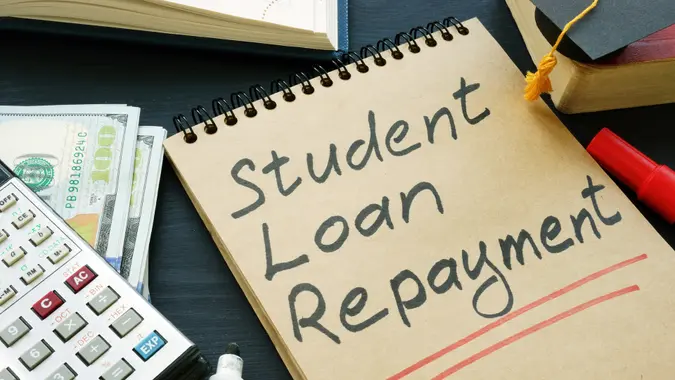What Is a Federal PLUS Loan?

Commitment to Our Readers
GOBankingRates' editorial team is committed to bringing you unbiased reviews and information. We use data-driven methodologies to evaluate financial products and services - our reviews and ratings are not influenced by advertisers. You can read more about our editorial guidelines and our products and services review methodology.

20 Years
Helping You Live Richer

Reviewed
by Experts

Trusted by
Millions of Readers
College expenses are higher than ever, with the average cost of college in the United States now amounting to around $38,270 per year when accounting for tuition, books, supplies, housing, and daily living expenses. Financial aid is increasingly important, with 72% of undergraduates requiring some sort of financial aid to pay for school.
Federal PLUS loans are currently funded through the Department of Education, providing funding for eligible graduate students, professional students and parents of undergraduate students to help pay for college or career school.
Types of Federal PLUS Loans
There are two main types of Plus loans, which allow either parents or students to take out loans, respectively.
Federal Parent PLUS Loan
Federal parent PLUS loans are available for biological or legal adoptive parents of the students, or the spouse of the student’s biological or adoptive parent. You must meet the following criteria:
- You don’t have an adverse credit history.
- You meet basic federal aid requirements.
- You hold U.S. citizenship or eligible non-citizen status.
These loans allow you to borrow a balance up to the costs of attendance, minus other financial aid that the child will receive. The cost of attendance is determined by the school.
Parent PLUS loans have fixed interest rates and a small origination fee.
Federal Graduate PLUS Loan
These loans are available for students pursuing graduate school, or “professional” students who are enrolled at least half-time at an eligible school that will lead to a graduate degree, professional degree, or a professional certificate.
You must meet all the requirements for financial aid, and not have an adverse credit history.
Eligibility Requirements for PLUS Loans
To be eligible for a PLUS loan, you must meet either be a parent of a student who is enrolled in school at least half-time, or you’re a professional or graduate student who is enrolled in school at least half-time.
That student must maintain satisfactory academic progress in order to stay eligible for the loan. Each school may have their own policy, but this will include taking a certain amount of classes, getting good grades and maintaining a certain (often passing) GPA.
You also can’t have anadverse credit history,which is defined as:
- Having one or more debts with an outstanding balance greater than $2,085 that are 90 or more days delinquent.
- Having a balance of this size that’s been placed in collection or charged off in the two years preceding the credit report.
- Have been subject to wage garnishment, tax lien, default determination, bankruptcy, foreclosure or repossession in the past five years.
If you do have an adverse credit history, you can obtain an endorser, which would act like a co-signer. They’d agree to pay the student loan balance if the borrower can’t pay. You may also try to file an appeal that includes documentation detailing extenuating circumstances, such as an illness, death in the family, or other personal hardship.
Application Process for PLUS Loans
To apply for a PLUS loan, follow these steps:
- Complete the Free Application for Federal Student Aid (FAFSA).
- Submit the relevant PLUS loan application.
- During the application process, you’ll be asked critical information like your name, address, income, and current debt.
- Agree to a credit check.
- Review and sign the Master Promissory Note (MPN), which is a legal document in which you promise to repay your loan and accrued interests.
- Before you accept a loan, make sure you fully understand all the terms and conditions.
Interest Rates and Fees
PLUS loans offer fixed interest rates and charge loan origination fees.
Loans disbursed on or after July 1, 2024 and before July 1, 2025 will have a fixed interest rate of 9.08% for the lifetime of the loan.
Origination fees have been charged at 4.228% of the loan’s total value since October 1, 2020. These fees can increase the overall cost of the loan, and should be considered.
Other federal student loan programs typically have lower interest rates. Direct Unsubsidized Loans have an interest rate of 8.08%, while Direct Subsidized Loans have an interest rate of 6.53%.
Repayment Options and Strategies
Having a repayment plan in place can help you pay off your loan quickly.
There are different repayment plans you can consider:
Federal PLUS loans provide essential funding for both parents supporting undergraduate students (Parent PLUS) and graduate/professional students (Grad PLUS). Understanding your repayment options is crucial for effective loan management.
Repayment Plans
PLUS loan borrowers can choose from several repayment plans to fit their financial situation:
- Standard Repayment Plan: Fixed monthly payments over 10 years, resulting in the lowest total interest paid.
- Graduated Repayment Plan: Payments start lower and increase every two years, with the loan paid off within 10 years (or 30 years for consolidation loans).
- Extended Repayment Plan: Allows repayment over 25 years with either fixed or graduated payments, available to borrowers with more than $30,000 in Direct Loans.
While Graduate PLUS borrowers can access income-driven repayment plans, Parent PLUS loans are only eligible after consolidation into a Direct Consolidation Loan.
Deferment and Forbearance
Both types of PLUS loans offer temporary relief options:
- Deferment: Allows postponement of payments in specific circumstances, including enrollment in school at least half-time, unemployment, or economic hardship.
- Forbearance: Temporary payment suspension or reduction when you don’t qualify for deferment but face financial difficulties.
To apply for either option, contact your loan servicer directly and submit any required documentation proving eligibility.
Loan Consolidation
Consolidating multiple federal loans, including PLUS loans, can simplify repayment with a single monthly payment. For Parent PLUS borrowers, consolidation opens access to Income-Contingent Repayment. Consider that consolidation may extend your repayment term and potentially increase total interest costs.
Strategic Repayment Management
Successful PLUS loan repayment requires proactive financial planning:
- Create a detailed budget that prioritizes loan payments.
- Consider automatic payments to receive a 0.25% interest rate reduction.
- Explore loan forgiveness options for eligible Graduate PLUS borrowers.
- Make additional payments when possible to reduce overall interest costs.
Pros and Cons of Federal PLUS Loans
There are both pros and cons when you’re considering using federal PLUS loans.
The advantages include:
- Higher loan limits than you may get with other lenders, allowing you to fund college costs in their entirety.
- Fixed interest rates, which offer financial certainty.
- Flexible repayment options, with potential deferment while the student is enrolled in school at least half-time and for six months after the student graduates.
Disadvantages include:
- Credit check requirements, with funding unavailable to those with “adverse credit histories.”
- Accumulation of interest during deferment, which can add up quickly and increase total repayment costs significantly.
- Impact on the borrower’s financial future, as it increases debt utilization and debt-to-income ratio, which may impact your financial standing and your ability to be approved for auto loans or mortgages.
Alternatives to Federal PLUS Loans
If federal PLUS loans aren’t right for you, or if you want to supplement them with alternative financing, there are several options available.
Scholarships and grants offer free funding that doesn’t require repayment. There are a variety of scholarships and grants offered by schools, government programs, local community organizations and more. Search online, and students can ask for information from their school’s guidance counselor.
Employer education assistance programs may also be a good option. Some employers will cover some tuition costs for their employee or the dependents of their employees.
There are also Federal Direct Subsidized and Unsubsidized Loans.
Direct Subsidized Loans are available to students who have greater financial need, and the Department of Education will pay interest on the loan while you’re in school, for the first six months after graduation, and during a period of deferment.
Unsubsidized Loans are available to students regardless of financial need. The borrower is responsible for interest throughout the lifetime of the loan.
Finally, there are private student loans. These loans can occasionally have fewer eligibility requirements, depending on the lender, but they are also likely to have higher interest rates and less ideal loan terms. Some may have adjustable interest rates, and these loans are ineligible for federal forgiveness programs.
What Are The Future of Federal Student Loans?
Federal PLUS loans– and other federal loan products– are funded through the Department of Education. The current administration has taken steps to dismantle the Department of Education (DOE), and there’s an expected executive order that may be aimed at eliminating the DOE.
Some people believe that some functions, including overseeing student loans, may stay at a reduced agency. There’s also the possibility that student loans will be overseen by another agency such as the Treasury Department. As things change quickly, watch how federal funding may be impacted.
FAQ
The majority of students in the United States need some type of financial aid, and federal PLUS loans may be a good solution. Let's look at a few common questions and answers about PLUS loans.- Can a Parent PLUS Loan be transferred to the student?
- No, parent PLUS loans cannot be transferred to the student. It remains the parent’s financial responsibility even after the student graduates.
- What happens if a PLUS Loan application is denied?
- If a PLUS loan application is denied, you can:
- Obtain an endorser
- File an appeal
- Apply for a Direct Subsidized or Unsubsidized Loan
- Discuss alternative financial aid options with your school
- If a PLUS loan application is denied, you can:
- Are there loan forgiveness options for PLUS Loans?
- Yes, there are currently loan forgiveness options for PLUS loans, including graduate and professional loans and parent loans.
- How does interest accrue on PLUS Loans during deferment?
- Interest accrues on all Direct Plus loans during deferment periods, including while the student is still in school and even though regular payments aren’t yet required.
- What are the tax benefits associated with PLUS Loan interest payments?
- Loan holders may be able to deduct up to $2,500 a year on interest paid on PLUS loans.
Our in-house research team and on-site financial experts work together to create content that’s accurate, impartial, and up to date. We fact-check every single statistic, quote and fact using trusted primary resources to make sure the information we provide is correct. You can learn more about GOBankingRates’ processes and standards in our editorial policy.
- Federal Student Aid "Direct PLUS Loans for Parents"
- Federal Student Aid "Basic Student Eligibility Criteria"
- Federal Student Aid "Direct PLUS Loans are federal loans that graduate or professional students and parents of dependent undergraduate students can use to help pay for college or career school."
- Federal Student Aid "Interest Rates and Fees for Federal Student Loans"
- Federal Student Aid "Standard Repayment Plan"
- Federal Student Aid "The Graduated Repayment Plan starts with lower payments that increase every two years."
- Federal Student Aid "The Extended Repayment Plan allows you to repay your loans over an extended period of time."
- Federal Student Aid "How do I check if I am on auto pay for my monthly student loan payment?"
- Federal Student Aid "As a parent PLUS borrower, can I transfer responsibility for repaying the loan to my child?"
- Federal Student Aid "PLUS Loans: What to Do if You’re Denied Based on Adverse Credit History"
- Federal Student Aid "Are Direct PLUS Loans eligible for Public Service Loan Forgiveness (PSLF)?"
 Written by
Written by  Edited by
Edited by 
























